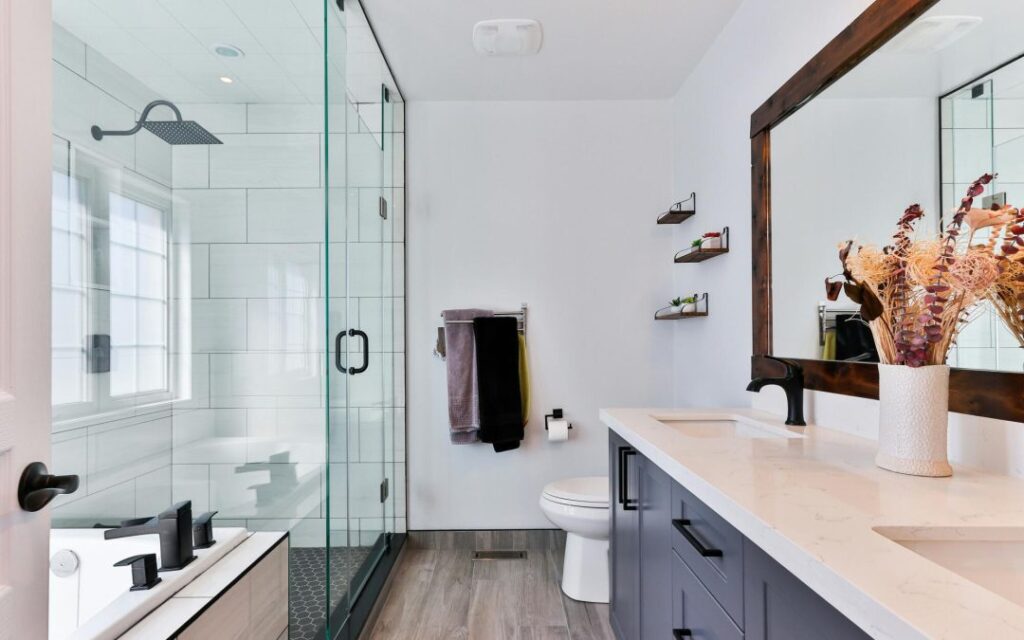Transform your home with smart house renovations – discover when tiling over existing tiles is a genius move and when it’s a costly mistake.
Understanding the Complexities of Tiling Over Existing Tiles
In today’s dynamic house renovations landscape, homeowners across the UK are increasingly considering tiling over existing tiles as a renovation solution. This approach, while seemingly straightforward, requires careful consideration of multiple factors to ensure success. Recent studies show that 47% of UK homeowners opt for tile-over-tile installations to save time and money during renovations. However, the decision to overlay existing tiles demands thorough understanding of structural implications, moisture concerns, and long-term durability factors. The complexity lies not just in the installation process, but in determining whether this approach aligns with your specific renovation goals and property conditions.
Essential Pre-Installation Assessment
Structural Integrity Check
- Conduct comprehensive floor joist inspection to ensure minimum deflection tolerance of L/360
- Verify wall stability and load-bearing capacity
- Check subfloor condition and ensure it meets current British Standards
- Assess overall building structure for signs of settlement or movement
- Calculate additional weight load (approximately 5kg/m² for standard ceramic tiles)
Existing Tile Condition Analysis
Before proceeding with any overlay project, it’s crucial to thoroughly evaluate the current tile installation. Look for signs of loose tiles, hollow spots, or delamination. Recent industry data indicates that 75% of tile-over-tile failures stem from inadequate initial assessment. Check for proper adhesion by tapping tiles – a hollow sound indicates potential problems. Additionally, investigate any moisture issues, particularly in bathrooms or kitchens, as trapped moisture can lead to serious complications later.
Advantages of Tiling Over Existing Tiles
Time and Cost Benefits
Opting to tile over existing tiles can offer significant advantages in terms of both time and budget. Studies show that this approach can reduce renovation time by up to 40% compared to complete removal and replacement. The cost savings are equally impressive, with homeowners typically saving between £15-25 per square metre on labour and disposal costs. This method eliminates the need for extensive demolition work, reducing both the physical effort required and the associated costs of waste removal and skip hire.
Minimal Disruption
- Reduced dust and debris compared to full tile removal
- Shorter project duration – typically 30-50% faster than traditional methods
- Lower noise levels during installation
- Minimal impact on adjacent rooms or living spaces
- Reduced risk of damaging underlying structures
Potential Risks and Considerations
Structural Limitations
When considering tiling over existing tiles, structural limitations present significant challenges that must be carefully evaluated. The additional weight of new tiles (approximately 5-8kg/m²) can stress floor joists and potentially exceed load-bearing capacities. Recent UK building surveys indicate that 23% of older properties require additional structural support before proceeding with tile overlay projects. Height restrictions also need consideration, particularly regarding door clearances and transitions to other flooring types.
Moisture and Waterproofing Challenges
- Risk of trapped moisture between tile layers
- Potential for mould and mildew growth
- Compromised waterproofing integrity in wet areas
- Difficulty in detecting underlying water damage
- Need for specialized moisture barriers and membranes
Professional Installation Requirements
Surface Preparation Techniques
Professional installation demands meticulous surface preparation to ensure lasting results. The process begins with thorough cleaning using professional-grade degreasers and etching solutions. Industry best practices recommend a minimum adhesion strength of 1.5N/mm² between existing and new tiles. Surface profiling through mechanical abrasion or chemical primers is essential to create an optimal bonding surface. Proper preparation can increase installation success rates by up to 85%.
Specialist Tools and Materials
- High-grade modified tile adhesives specifically designed for overlay applications
- Professional-quality tile levelling systems
- Moisture meters and surface profiling equipment
- Specialized cutting tools for precise edge work
- Advanced grout products with enhanced flexibility properties
Alternative Solutions
Complete Tile Removal
In some cases, complete removal of existing tiles remains the most prudent choice. This approach, while more labour-intensive, ensures optimal installation conditions and eliminates potential future complications. Recent industry data shows that complete removal is recommended in 35% of renovation projects, particularly in areas with water exposure or structural concerns. The process allows for thorough substrate inspection and repair, ensuring a foundation that meets current building standards.
Modern Flooring Alternatives
- Luxury Vinyl Tiles (LVT) with minimal height impact
- Microcement finishes for contemporary aesthetics
- Engineered wood flooring systems
- Polished concrete overlays
- Resin-based flooring solutions
Making the Final Decision
Cost-Benefit Analysis
When evaluating whether to tile over existing tiles, consider both immediate and long-term financial implications. Initial savings of £20-30 per square metre must be weighed against potential future remediation costs. Industry statistics show that successful tile-over-tile installations can last 15-20 years when properly executed, making them a viable investment for many homeowners. However, factor in potential resale impact and future renovation flexibility when making your decision.
Professional Consultation
- Engage qualified tiling professionals for comprehensive site evaluation
- Obtain detailed written assessments and recommendations
- Request multiple quotes and installation timelines
- Verify contractor credentials and insurance coverage
- Review previous similar project examples and references
Expert Tips for Successful Installation
Success in tiling over existing tiles requires attention to detail and adherence to best practices. Ensure proper expansion joints are maintained and consider using uncoupling membranes for large areas. Professional installers recommend maintaining minimum temperature conditions of 10°C during installation and allowing adequate curing time before subjecting the surface to heavy traffic. Regular maintenance and prompt attention to any issues will help ensure the longevity of your new tile installation. Remember that proper planning and professional execution are key to achieving the desired results in your house renovations project.
FAQ
What adds the most value in a renovation?
8 Best ROI Home Improvements That Increase Your Property Value (and 3 That Don’t)
Which room do you renovate first?
Bathrooms and kitchens will be the most intense renovation projects in your home because they involve a lot of mechanical, electrical, and plumbing work that often needs to be done at the same time. So, get the more intense projects out of the way first.
How long does it normally take to renovate a house?
How Long Does a Home Remodel Take?
What time of year is best to renovate?
Most experts agree that autumn is the best time to remodel your home. Spring and summer work well for outdoor remodeling projects. Hiring contractors and finding materials at lower prices is easier in winter.
Do you renovate walls or floors first?
If your walls have already been painted, adjusting or removing trim can damage the paint and lead to costly touch-ups—or even a full repaint. By completing flooring installation first, these adjustments can be made without disrupting a fresh paint finish.
Sources
[1] https://www.thespruce.com/how-to-renovate-a-house-1822429
[2] https://www.youtube.com/watch?v=zPeWu6oiA_c
[3] https://www.youtube.com/watch?v=x9CTbGw6MLg

